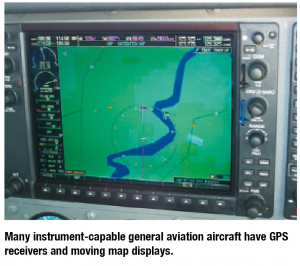Air traffic management technology: Next Gen. Avionics Explained
The United States’ Federal Aviation Administration is well underway with the implementation of its Next Generation air transportation system. This represents a radical overhaul of the manner in which air traffic is managed and controlled. By the time 2025 rolls around (the projected year of completion), the aviation landscape will be vastly different from the environment in which we presently operate.
Like all aspects of life in the 21st century, the world of aviation cannot help but be reshaped and restructured as a result of massive developments in electronic information technology. At the root of it all, it is these advancements in information exchange and transfer that are driving and mandating the changes proposed in the NextGen initiatives.
With the ever-increasing amount of air traffic, issues of safety and congestion become more acute. Traditional — or current generation — technologies associated with air traffic control (ATC), flight planning, collision avoidance (TCAS) and so on, limit the rate at which flights can be dispatched, controlled and separated. This results in congested taxiways, delayed take-off and landing clearances, longer routes and flight times, plus the associated costs of fuel burn, crew times, and passenger/cargo revenues.
The goal of the NextGen project is to employ technologies which will enhance air traffic control safety and coverage, enable more direct flight paths, expedite aircraft/ATC control communications, simplify and expand weather warning and avoidance systems, and reduce the amount of separation time and space between flights. This is all achievable using existing, albeit new technologies which undoubtedly will continue to advance over the course of the implementation schedule. Global Positioning Systems (GPS) have become an integral part of the aviation world as well as virtually every automobile and cellphone, and represent a key element in the structure of the FAA’s NextGen model.
The most revolutionary aspect of the NextGen paradigm is the shift from the current ground-based ATC systems to the satellite-based Automatic Dependent Surveillance-Broadcast (ADS-B) technology.
To understand the scope of this change, let’s review how these two systems operate.
The current ATC systems use ground-based interrogators (those big, rotating antennas seen at airports) that transmit radio signals, called interrogation pulses, as they spin around and around. When an aircraft equipped with an ATC transponder receives these interrogation pulses, the aircraft’s transponder is triggered and it sends reply pulses back to the interrogator.
Based on the amount of elapsed time between sending the interrogation and receiving the reply, the ATC interrogator is able to determine the distance between the interrogator antenna and the aircraft sending the reply. The rotation of the interrogator antenna is synchronized with the air traffic controller’s display screen and therefore the position of the aircraft can be displayed on the controller’s screen. If the transponder is operating in Mode C (altitude encoding mode), the altitude of the aircraft is also displayed. This allows the controller to see the position, distance and altitude of the aircraft on their screen. This information is available only to the ATC controller, not to any other aircraft in the control zone.
ADS-B, on the other hand, uses information from the aircraft’s GPS to determine its present position in three-dimensional space (latitude, longitude and altitude). This information is then transmitted not only to the ATC facility, but also to all other aircraft in the vicinity. In addition to position and altitude information, ADS-B equipped aircraft transmit heading and speed information. All of this data can be graphically displayed on the navigation screens in the cockpits of other ADS-B equipped aircraft. This means it is no longer just the air traffic controller who can see the position of traffic in the control zone, but all suitably equipped aircraft can also access this information.
The benefits of ADS-B based air traffic control are tremendous. Pilots will have the advantage of significantly increased situational awareness regarding the proximity of other aircraft. Air-to-air and air-to-ground data communications will allow for computer-controlled collision avoidance manoeuvres and eventually interval spacing co-ordination.
Data communications also represent one of the more significant aspects of NextGen initiatives. Much of routine air-to-ground/pilot-to-controller communications will shift from a voice format to a data exchange format. The relatively narrow bandwidth available for aviation VHF communications (118–137 MHz) means that the only way to meet the demand for more channels was to decrease the spacing, from 50 kHz to 25 kHz to 8.33 kHz.
A more effective way to deal with this problem is to reduce and eliminate much of the voice communications and replace them with data communications. For example, at a busy airport, pilots must patiently wait for a suitable opening to key their mikes to request pushback/taxi clearance. The controller will then reply with appropriate instructions — the whole process taking a significant amount of time and contributing to departure delays. Alternatively, using data communications enables requests for clearance and ATC responses to be transmitted in microseconds.
From an avionics perspective, the notion of data communications between airborne computers and ATC computers for the purpose of control, separation and collision avoidance is hugely exciting. With collision avoidance systems now being coupled to autopilots, we are seeing air-to-air data exchanges amongst TCAS computers, which result in commands being given to autoflight computers. In other words, the aircraft computers are “talking” to one another and actually executing flight manoeuvres based on these “conversations.” With the increased accuracy realized by the use of ADS-B based air traffic control, and the proposed increase in data burst communications, it seems inevitable that we will soon have commercial aircraft flying in tight formation, controlled by continuous stream data exchanges.
A third aspect of the NextGen avionics transformation involves weather information systems. Traditional airborne weather radar systems tend to be somewhat limited in range and effectiveness, and can be heavy, costly and even potentially dangerous. Once again, electronic information exchange and data transfer enables the assembling of weather information from multiple sources, such as satellite, airborne and ground-based weather monitoring facilities. All this information can then be transmitted to aircraft, enabling accurate, real-time weather condition information that is available for flight planning and execution purposes.
These are just some of the more salient aspects of NextGen technology that represent significant changes and developments from an avionics perspective.
While these transformations are tremendously exciting to those of us involved in the technical side of the operation, they are not without concern and controversy within other sectors of the aviation community.
The notion of reducing the role of pilots and air traffic controllers as we shift control from human to computer operations and controls remains a very contentious issue. The cost of implementing equipment changes is also something to be considered as airlines and private owners ponder modification and installation costs for new avionics systems.
Of course, the greatest controversy surrounding The Next Generation continues to be “Who’s a better captain … Kirk or Picard?”
Q: What are some of the advantages of ADS-B over ground based air traffic control systems?
From the previous article:
Q1: What is the voltage drop across a resistor of 4.7KΩ with 238mA of current running through it?
Q2: A hydraulic press has an input cylinder 1 inch in diameter and an output cylinder 6 inches in diameter. Calculate the force exerted by the output piston when a force of 10 pounds is applied to the input piston.
Answer to Q1: 1119 volts
Answer to Q2: 360 pounds
About The Author
GORDON WALKER entered the avionics industry after graduation from Centennial College in 1980. His career with Nordair, Air Canada, CP Air, PWA, and ultimately Canadian Airlines took him to many remote corners of Canada. Since leaving the flight line to pursue a career as a college professor, Walker has continued to involve himself in the aviation/avionics industry, by serving on several CARAC Committees concerning the training and licensing of AMEs, being nominated to the CAMC Board of Directors, and being elected President of the National Training Association. (NTA).
View all articles by Gordon Walker.
















































